#snyder structure
Text
odnlb writing process/workshop
this is mainly for my own reference. however, if this post ends up helping you with yours, then even better! 😊
most of you know, i wrote this fic as a practice for using save the cat (aka snyder) structure, and so now that it's complete i have the outline to come back to in a way that i understand and can use in future wips! did i deviate from this structure? yes. a lot. did i still follow all the beats though? i think so! check out how i formatted my outline!
my starting point: marinette 🐞
want: revenge against monarque
need: replace hate with love
this gave me a very clear picture of the emotional journey she would undergo. once i figured out her emotional need and decided what she would do to fulfill that need, i was able to pretty much plot out the entire fic. we needed a hero (in her case, an anti-hero) we could follow through an entire 45 chapter fic, and odnlb marinette gave us a reason to care about her and root for her right off the bat!
here's what save the cat's 15-beat structure looks like at a glance:
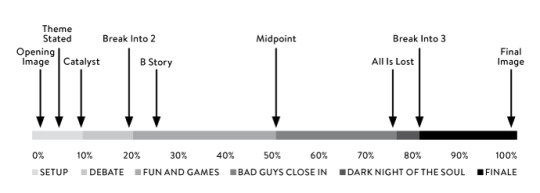
(isn't it just beautiful? 😍)
for odnlb, i combined this structure with the 3-act, 9-block, 27-chapter method:

lol so i did not exactly stick to this, as was my plan (my huge cast of characters wanted more from me.) however, i did stick with the proper beats...it just ended up expanding into 5 acts.
this is how my outline ended up looking (orange = save the cat, purple = 3 act 9 block 27 chapters):
act 1 - ladybug meets the villains
block 1
opening image - marinette leaves a rose at chat noir's statue. her eyes are dead (like him)
introductions/setup - 6 years later, marinette works for chloe. adrien still models for gabriel & is estranged from her and his old friends
theme stated - alya says, "you're getting better." (marinette has not been focused on hatred, but her personal growth)
catalyst/ inciting incident - bunnyx steals the rabbit miraculous & draws out the villain team
debate/ immediate reaction / fallout - villain team decides to abandon plan to use rabbit miraculous & get ladybug's miraculous instead. marinette decides to get cat walker's miraculous & kill monarque with it.
block 2
actions - ladybug interrogates adrien agreste bc he is close to lila, chloe, and felix (primary suspects). he doesn't give her any information, but reassures her he is on her side.
consequences - volpina attacks ladybug, villain team overpower her
block 3
pressure - ladybug is outnumbered, cannot stand against all the holders & their power-ups. villain side: ladybug is onto them. ladybug needs an ally & turns to kagami (also close to felix), but kagami turns ladybug down (but why?).
pinch/plot twist - cat walker contacts ladybug: tells her monarque is going to resume akuma attacks unless lb gives her miraculous
break into act 2 - monarque attempts to akumatize ladybug, but cat walker saves her. realizes villains' motivations are split.
act 2 - rise of monarque
block 4
new world - luka and zoe come to town. adrien is in trouble but felix stands by him. su han abandons marinette; he cannot teach her bc she has too much hatred.
fun and games/ b story/ies - felix and adrien switch so adrien can meet his friends for drinks. chloe sneaks snake miraculous back to luka. felix and lila threaten each other. felix likes kagami.
bad guys close in - monarque akumatizes nino to punish adrien. marinette finds out cat walker is a sentimonster
juxtaposition/ old vs new - luka/aspik shows up & joins marinette's side (she's not alone anymore). adrien realizes he has to be alone bc of what happened to nino. kagami confronts felix and gets the dragon miraculous (war begins)
act 3 - adrien identity reveal
block 5
build-up - luka and marinette plot to find the sentimonster. luka confronts adrien indirectly, suspects monarque is gabriel. marinette sleuths on felix (suspected peacock holder) only to discover adrien is a sentimonster/cat walker. kagami finds ladybug & offers to spy on felix & the villain team for her. monarque akumatizes zoe to punish chloe. ryuko gets her felix's amok in the fight, but gets it back when ladybug uses it against him. to stop ladybug harming argos & ryuko, luka reveals chat noir is still alive.
midpoint - montparnasse scene: ladybug confronts cat walker, he admits the truth. stand off with monarque until aspik & mellona rescue ladybug.
reversal - marinette is no longer hate driven, but driven by love to save adrien
act 4 - angrybug reversal
block 6
reaction - due to big emotional distress, ladybug goes into the avatar state (foreshadowing 👀). luka and chloe calm her down. feligami get together. adrien pleads to his father not to harm ladybug.
action/trials (raise the stakes) - the more adrien breaks his amok, the more he breaks his miraculous. marinette is set up to "spy" on adrien for the villain team. villain team plot to corner ladybug at dj wifi wedding.
dedication - adrinette kiss scene. adrien promsies himself he will harm himself before he lets harm come to ladybug. marinette promises no more harm will come to him.
block 7
calm before the storm - lila flashback: she killed nathalie and has been akumatized/transformed for 6 years. balcony scene: marinette tries to keep adrien close to no avail.
pinch/plot twist - volpina and monarque attack chloe, luka, and zoe. vesperia and carapace get their miraculous back. ladybug tries to heal cat walker & free him with her power, but his miraculous is too broken. she can only save him by getting his amok.
everything goes wrong/ dark night of the soul/ all is lost - lila & felix flashback: lila is monarque reveal. ladybug confronts gabriel agreste & tries to kill him, but can't (bc she is no longer full of hate). realizes monarque is lila. monarque takes felix, but kagami takes the other miraculous back to ladybug.
act 5 - fall of monarque
block 8 - finale
power within - team assemble. chloe uses mouse miraculous to activate other holders. lila finds marinette's identity.
action - monarque attacks. luka sacrifices himself to get the upper hand. alya gets the fox miraculous off lila, all her illusions drop. lila akumatizes timetagger, bunnyx shows up to get him. team fights argos and his sentimonster, red moon, to the death. chloe incapacitates argos.
converge - monarque takes the senti-twins and runs. remainder of the team follow her to agreste mansion.
block 9
final confrontation/final battle - monarque tries to make felix fix her miraculous. ladybug and team show up. monarque morphs into monster and attacks. gabriel sacrifices himself to save lb, but monarque still gets the upper hand. chat noir cataclysms monarque with a broken miraculous.
climax - the broken cataclysm destroys the world, but carapace's shield protects remainder of team. with adrien gone, felix is free and emilie is awake. ladybug goes toe-to-toe with broken miraculous final form chat noir, but her power is too weak compared to his untethered destruction. then felix gives her the peacock miraculous and she uses it to create a new bond for adrien, tethering him to life with her love.
resolution/denouement - all of paris knows chat noir is alive! big parade for heroes. ladybug and chat noir do a william and kate kiss. alya shoos off su han. felix gives gabriel to chloe and decides to work for tsurugi tech so he can stay with kagami. zoe and luka decide to go back home for a bit then come to stay too. emilie wants to be close to felix and adrien, but she is def not the priority for them atm. marinette takes the butterfly miraculous back from emilie. adrinette go off on a honeymoon vacation. adrien practices his proposal on a beach.
final image - adrien and marinette playing in the water on a beach on la reunion. “camera” pans away from their silhouettes running around on the sand, back to their stuff on the beach. shows a ring box in adrien’s bag with plagg & tikki chilling.
if this helped you out, i'm so glad! it definitely helped me see how to organize a story. i think if i ever do a fic like odnlb again, i will definitely do this for it.
#i finally finished answering all my comments lol#and i thought i'd do this now while the story is still fresh in my memory!#hopefully this will be helpful to other people as well as me#i just know i would have liked a map-out of a story i knew very well with all the proper beats#but now that i know i CAN do this kind of story with this kind of structure then i know i can do it again#also i am not claiming to be a story structure expert by any means#i am just sharing how i did it and how i see it#i could be totally off about some of these!#constructive criticism is always welcome <33#also i am not saying this is the only way to tell a story#save the cat is definitely not the end all be all of narrative formulas#many stories are told according to different structures! and told well!#this is just the one i wanted more practice with#and one i thought fitting for odnlb since it was such a huge story#odnlb#one does not love breathing#snyder structure#save the cat#3 act 9 block 27 chapter method#writing#story structure#5 acts#might update this as we go forward
62 notes
·
View notes
Text
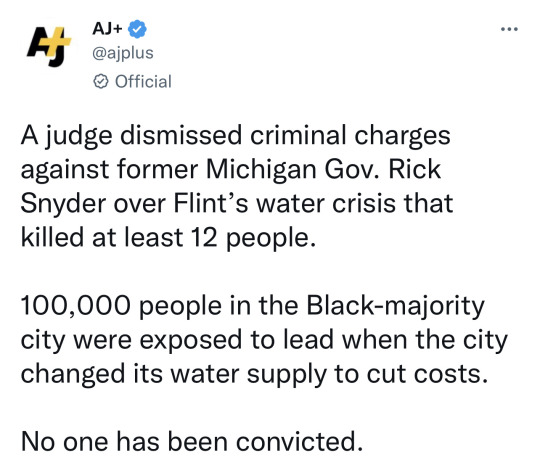

The American “justice” system, working exactly as intended. Rick Snyder casually poisoned an entire city full of Black people. He should get the electric chair.
#flint#rick snyder#politics#republicans#structural racism#republicans are evil#white on black crime#systemic racism
82 notes
·
View notes
Text

no ❤️
#you are outlining a miniseries that structurally makes no sense. introducing each member of an ensemble in an episode dedicated to them?#have you EVER seen that work in tv. no. besides again: Snyder is a feature director—he’s not gonna make the switch to TV at this point.#it’s a different world despite the blurred lines b/w film and TV in recent years#it just doesn''t work like you think. TV isn't just Long Film—and you could NOT pitch or sell it as a 2 season miniseries. doesn’t exist!#turning it into a show creates more problems that it solves frankly!#and actually what you’re looking for—better pacing and characterization—is likely there in the longer cut#because your ACTUAL criticism is that the film felt rushed. which it is! because it’s basically an abridged version!#tumblr media studies (derogatory)
1 note
·
View note
Text
If the DC universe gets rebooted after the Warner Bros/Discovery merger, I hope that they at least keep the Shazam movies canon.
#dceu#i've made my peace with the snyder verse not happening#and besides the structure is practically all over the place compared to the mcu#shazam
2 notes
·
View notes
Note
why do you hate the court of owls??
i answered that here, but the short of it is that even if we ignore the anti-semitic tropes snyder accidentally engages with, the court of owls existing as a concept is the anti-thesis to the core ideal of bruce's crusade - that anyone can experience loss, regardless of status, and that harm can be entirely random and caused by systemic problems of a failing society. fundamentally, batman and robin aren't made cooler because their parents were murdered by the evil bird brigade.
bruce wayne sees dick grayson experience the same grief he had, and makes a change. thomas and martha wayne and mary and john grayson are killed because of social inequality, a lack of upward social mobility, collapsing social support structures, and a deep corruption within the systems that are supposed to help vulnerable people. it's a very deliberate commentary that court of owls weakens. batman and robin aren't preordained, destined, or meant to save gotham through the machiavellian plottings of a bunch of people in a sewer. they save gotham because they decide to do good.
208 notes
·
View notes
Text
Can people even call the wraith scratch theory a theory at this point? And I know theories are theories until proven but It's basically already confirmed canon. I know it hasn't been confirmed yet but there is so much evidence to back it up it baffles me how people still don't believe it's true.


Comparisons, the noses are literally the same shape, the hair has the same shape, they have the same double chin, they both have the same structural face format, hell have you not even noticed that scratch and Todd are played by the same guy, DANA SNYDER!!! Wraiths have already been introduced to be a thing along with Molly's soul-less body when she's not in it! It has a greyish tone (Todd has a grey tone to him, hell he literally wears grey clothes) along with the soul-less body sounding dead and toneless (again Todd has the same thing). And don't say "Well he can't be a wraith because he sometimes shows emotion" no shit he shows emotion, have you not realized how long he and scratch have been separated? Todd is basically his own person. We don't have a time frame as of writing this but it has too have been a pretty long time. We do know that scratch has been a "ghost" for many years and doesn't remember a thing.


Another thing, scratch and Todd both love food, the only time we've seen Todd smile is when there is FOOD INVOLVED in the episode "Festival of lights"!!! And if you know scratch you know he will literally do anything to eat anything, he will eat garbage, he will eat literal objects, he loves food. Honestly you don't even need to know him to know he loves food, because most times when he's around hes either eating or begging for something greasy.
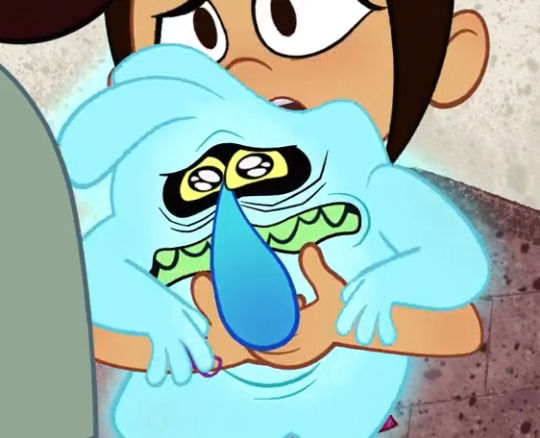

Honestly I don't even know how someone can still deny this theory. This feels like the Steven universe corruption theory all over again. Sorry this was long I just had to let this all out because it is crazy how many people I've seen still disbelieve this. And many people on Tumblr have already made their thoughts on it, I just wanted to post this before the episodes came out to give my final thoughts on it.

Final thoughts:
Scratch is Todd confirmed screw you if you think otherwise.
106 notes
·
View notes
Text
Interesting Papers for Week 30, 2023
Adult-born neurons inhibit developmentally-born neurons during spatial learning. Ash, A. M., Regele-Blasco, E., Seib, D. R., Chahley, E., Skelton, P. D., Luikart, B. W., & Snyder, J. S. (2023). Neurobiology of Learning and Memory, 198, 107710.
Behavioral origin of sound-evoked activity in mouse visual cortex. Bimbard, C., Sit, T. P. H., Lebedeva, A., Reddy, C. B., Harris, K. D., & Carandini, M. (2023). Nature Neuroscience, 26(2), 251–258.
Exploration patterns shape cognitive map learning. Brunec, I. K., Nantais, M. M., Sutton, J. E., Epstein, R. A., & Newcombe, N. S. (2023). Cognition, 233, 105360.
Distinct contributions of ventral CA1/amygdala co-activation to the induction and maintenance of synaptic plasticity. Chong, Y. S., Wong, L.-W., Gaunt, J., Lee, Y. J., Goh, C. S., Morris, R. G. M., … Sajikumar, S. (2023). Cerebral Cortex, 33(3), 676–690.
An intrinsic oscillator underlies visual navigation in ants. Clement, L., Schwarz, S., & Wystrach, A. (2023). Current Biology, 33(3), 411-422.e5.
Not so optimal: The evolution of mutual information in potassium voltage-gated channels. Duran-Urriago, A., & Marzen, S. (2023). PLOS ONE, 18(2), e0264424.
Successor-like representation guides the prediction of future events in human visual cortex and hippocampus. Ekman, M., Kusch, S., & de Lange, F. P. (2023). eLife, 12, e78904.
Residual dynamics resolves recurrent contributions to neural computation. Galgali, A. R., Sahani, M., & Mante, V. (2023). Nature Neuroscience, 26(2), 326–338.
Dorsal attention network activity during perceptual organization is distinct in schizophrenia and predictive of cognitive disorganization. Keane, B. P., Krekelberg, B., Mill, R. D., Silverstein, S. M., Thompson, J. L., Serody, M. R., … Cole, M. W. (2023). European Journal of Neuroscience, 57(3), 458–478.
A striatal circuit balances learned fear in the presence and absence of sensory cues. Kintscher, M., Kochubey, O., & Schneggenburger, R. (2023). eLife, 12, e75703.
Hippocampal engram networks for fear memory recruit new synapses and modify pre-existing synapses in vivo. Lee, C., Lee, B. H., Jung, H., Lee, C., Sung, Y., Kim, H., … Kaang, B.-K. (2023). Current Biology, 33(3), 507-516.e3.
Neocortical synaptic engrams for remote contextual memories. Lee, J.-H., Kim, W. Bin, Park, E. H., & Cho, J.-H. (2023). Nature Neuroscience, 26(2), 259–273.
The effect of temporal expectation on the correlations of frontal neural activity with alpha oscillation and sensory-motor latency. Lee, J. (2023). Scientific Reports, 13, 2012.
Describing movement learning using metric learning. Loriette, A., Liu, W., Bevilacqua, F., & Caramiaux, B. (2023). PLOS ONE, 18(2), e0272509.
The geometry of cortical representations of touch in rodents. Nogueira, R., Rodgers, C. C., Bruno, R. M., & Fusi, S. (2023). Nature Neuroscience, 26(2), 239–250.
Contextual and pure time coding for self and other in the hippocampus. Omer, D. B., Las, L., & Ulanovsky, N. (2023). Nature Neuroscience, 26(2), 285–294.
Reshaping the full body illusion through visuo-electro-tactile sensations. Preatoni, G., Dell’Eva, F., Valle, G., Pedrocchi, A., & Raspopovic, S. (2023). PLOS ONE, 18(2), e0280628.
Experiencing sweet taste is associated with an increase in prosocial behavior. Schaefer, M., Kühnel, A., Schweitzer, F., Rumpel, F., & Gärtner, M. (2023). Scientific Reports, 13, 1954.
Cortical encoding of rhythmic kinematic structures in biological motion. Shen, L., Lu, X., Yuan, X., Hu, R., Wang, Y., & Jiang, Y. (2023). NeuroImage, 268, 119893.
Mindful self-focus–an interaction affecting Theory of Mind? Wundrack, R., & Specht, J. (2023). PLOS ONE, 18(2), e0279544.
#science#Neuroscience#computational neuroscience#Brain science#research#cognition#neurons#cognitive science#neural networks#neural computation#neurobiology#psychophysics#scientific publications
75 notes
·
View notes
Text
Strong Act Structure Creates Stronger Stories
by @septembercfawkes
In storytelling structure, people use the term “act” rather broadly and vaguely. Most in the writing community break stories down into three acts: beginning, middle, and end. But if you asked many writers what an act actually is, they would probably give you blank stares.
Despite acts being key structural units in stories, they don’t get a lot of attention.
And when they do, they are often treated simply as containers to fill with beats from a beat sheet.
Luckily, the basics of acts aren’t too hard to grasp, if you already know the basics of structure.
And once you grasp acts, your whole story will have not only better structure, but better pacing and better direction.
So let’s unpack the act!

As mentioned, those who usually give the act any mind, are often following a “beat sheet.” This is a list of key moments (or “beats”) that are supposed to happen in a specific order, and usually, at a specific time, to make a story more satisfying (put simply). Beat sheets can be very helpful and very effective. Two of the most popular are Save the Cat! by Blake Snyder and Vogler’s version of The Hero’s Journey. Another common structural approach is 7 Point Story Structure.
Often beat sheets will be separated into acts, so if you are familiar with them, you may have some understanding of what’s supposed to happen in each act.
If you aren’t familiar with them, that’s fine too.
Basic Story Structure
I’m going to explain acts from the bottom up–and we’ll get back to the beat sheets for those who like to “beat” out their stories.
At the most basic level, the structure of a story (almost) always looks like this:

It has a rising action, climax, and falling action.
If we zoomed in a little more, there would be an inciting incident. This is the turn in the beginning of the story that kicks off the main plotline–it often appears as an opportunity or a problem for the protagonist.
Charlie Bucket finding a golden ticket.
Peter Parker getting bit by a radioactive spider.
Boo coming into Monstropolis in Monsters Inc.
These are all examples of inciting incidents.
From there, the story escalates, more or less, until it gets to the climax, where the main conflict between the protagonist and antagonist hits a peak and gets resolved. This creates a turn that then leads to the falling action.
That’s basic structure.
Basic Structure and Structural Units
But it’s not only basic structure for a story as a whole, it’s also basic structure for just about any solid structural unit. Ideally, scenes should have this structure, sequences should have this structure, and yes, acts should have this structure.
Each unit fits inside the bigger unit, like a Russian nesting doll, or a fractal.
The difference is that, the smaller the structural unit, the smaller the impact.
So the climax of a single scene will be smaller than the climax of a sequence. (This term isn’t used very often, but a sequence is a string of related scenes, that don’t fill up a whole act.)
The climax of a sequence will be smaller than the climax of an act.
And the climax of an act will be smaller than the climax of the overarching story.
Basic Act Structure
Nonetheless, other than the story as a whole, the act is the biggest structural unit. This means each act should crest into a big turn in the story.
It’s not just that the story has one major peak–a turning point–at the end.
It should have several big peaks along the way.
It should also have several “valleys” along the way.
While the overarching story is escalating in general overall, it still has rises and falls in each act.
Most commonly, people view stories as having three acts.
This means the structure will look somewhat like this:
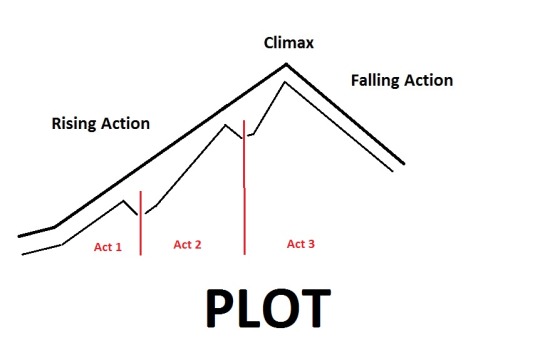
It’s also equally common to split the middle act in half. Frequently, in the middle of the second act, there is a major turn, called the midpoint (you may have heard of it). If this moment is major, it’s often more helpful to picture the structure with the second act split into two, something like this:
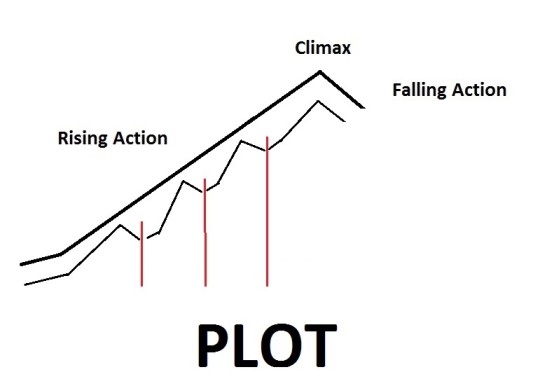
One may arguably call this a four-act story, but to keep with the most commonly used terms, it’s probably better to call these pieces, Act II, Part I & Act II, Part II.
When you look at this structure, you may realize something . . . there is no saggy middle! There is also no boring beginning, or lackluster end.
This is because there is a rise, peak, and fall within each act (and arguably two in Act II).
Frequently, people divide these act pieces into quarters. Not every writer likes using percentages, but it’s the best and easiest way to indicate when and where something in a story should typically happen–so we’ll use them.
Act I: 0 – 25%
Act II, Part I: 25 – 50%
Act II, Part II: 50 – 75%
Act III: 75% – 100%
Please note that the percentages aren’t laws; they are more like guidelines. But we need the guidelines to even have a proper conversation about acts. Once we understand the guidelines, we can play with variations for different effects, but we need to lay a foundation first to get anywhere.
The beautiful thing about this, though, is that you know you need to hit a peak in each of these quarters.
Now, occasionally, writers will cut some or all of the falling action off the structural unit. This is rare for the overarching story (but it does happen!). It is more common for smaller structural units. So don’t panic if all your units don’t have the “fall” into the valley.
Acts and Structural Pacing
The point is, you have peaks and valleys.
And it’s helpful to have them in the proper places. Why? Because this is what controls structural pacing.
Pacing is more than word count. In fact, pacing more closely links to structure. When the structure of any given unit is solid, the pacing will almost always be exactly what you need. The exception to this is when you are looking at the lines themselves–that’s when things like word count become more important.
Generally speaking, solid structure = solid pacing.
This is why when you understand acts, you’ll be less likely to have pacing problems in beginnings, middles, or ends (no saggy middles!).
Pacing gets tighter the closer it gets to the peaks, simply because the plot itself is becoming more intense.
Then it gets more leisurely and loose in the valleys, as we fall and/or begin the next climb.

Each Act’s Climax
Act I
So, when you are writing the beginning, you know you need to be climbing toward a big turn, which will hit before the middle.
What is this Act I climax?
Well, depending on what approach you are using, people will call it different things. (This is where those of you who are familiar with beat sheets pull yours out.)
In Save the Cat! This is the “Break into Two” beat.
In Vogler’s Hero’s Journey, this is “Crossing the Threshold.”
In 7 Point Story Structure, this is “Plot Point 1” (sometimes alternatively called “Plot Turn 1”).
If you aren’t familiar with any of these terms, that’s fine, but know Act I has a climactic turn.
This climactic turn works by locking the protagonist with the main conflict. It is typically marked by the protagonist’s choice to step forward, through a “Door of No Return” (i.e. Crossing the Threshold) or a “Point of No Return” (i.e. plot point). It’s what “breaks” the story into Act II.
The protagonist definitively chooses to go forward on the journey of the primary plotline. This is then usually followed by a transitional segment, that takes us into the “valley.” . . . There is a lot more I could go into here, but it’s beyond the scope of this article, so let’s move on.
The falling action is often a reaction segment–where the character is reacting to what just changed at the peak. Once the character has at least some sense of their situation, they usually start “climbing” toward a current goal (rising action).
Act II, Part I
Near the halfway mark of the story, you typically hit a climactic peak again. A big turn. People most frequently call this the “midpoint.” It usually involves the protagonist gaining new, important information that helps him move forward more aggressively, or rather, actively, against the antagonist. But it may be marked by a big victory or failure for him too.
The point is, there is a turning peak.
. . . which leads to “falling” into a valley . . .
And again, the falling action is often a reaction segment to whatever big change–revelation or action–just happened.
Act II, Part II
Once the character gets some sense of the situation, you know what she’s going to do? Start the climb toward the current goal. Rising action.
And of course, the climb is never easy. Every climb has conflict and stakes–that’s the only way to escalate the story (in other words climb the rising action).
She hits another major turn.
In Save the Cat! this moment coincides with the “All is Lost” beat.
In Vogler’s Hero’s Journey, it’s “The Ordeal” beat.
And in 7 Point Story Structure, this is (arguably) Plot Point 2 (but there is some ambiguity on how that term gets used in the writing community).
If you don’t know those terms, that’s fine, but just know that this is the major climactic moment of Act II (Part II).
And, most frequently, it leads to the biggest “fall” of the story–a big lully drop to a low, low valley. It’s usually the largest reaction segment of the story.
Well, guess what happens next?
Act III
After the character has taken some time to wallow in his failures, he’ll find his footing and start the last climb–to Act III’s climax, which is (almost) always simultaneously the climax of the whole story.
And that’s the basic structure of the story, through acts.
Acts and Inciting Incidents
Now, if we were to zoom in a bit more, we would likely find that each act also has an “inciting incident”–it’s usually what kicks off the next climb. It’s what gets the character to leave the valley and come up with a plan about what to do next (whether or not the plan plays out as intended).
The most recognizable one in storytelling approaches (other than the first one, in Act I) is Act III’s.
After Act II, Part II’s major lull, usually the protagonist gains something that pulls her out of the lull. If you are following along with your beat sheets . . .
Save the Cat! calls this “Break into Three.”
Vogler’s Hero’s Journey calls this, “Reward: Seizing the Sword.”
And (this is where the ambiguity creeps back in), this is often lumped in with “Plot Point 2” in 7 Point Story Structure.
But Act II will also usually have its own “inciting incident,” something that gets the character on track for the next climb.
And . . . if we went much deeper into structure, I’d probably need to fill up a whole book. So, we’ll end there.
Just make sure to mind the peaks and valleys of your acts–your story, agent, editor, and readers will thank you for it. Even if they don’t recognize what you are doing, they feel it.
(And you’ll probably thank yourself for it too!)
217 notes
·
View notes
Text
Kagurabachi's Popularity: Familiarity Through Structure
Having a degree in writing and media is so fun because I can write an essay on why Kagurabachi can be defined as well written through craft standards and attribute its popularity overseas to its structure, which is framed similarly to western movies.
And I am!
After this interview confirmed that Takeru Hokazono, author of Kagurabachi, is a huge fan of western films, I went back to this idea I was playing with in October when KB had less than ten chapters. I had been reading since day one, and I knew it was good, and other overseas fan knew it was good. But what made it so good to us, overseas?
I made a quick thread on it on my Twitter account (that I never posted) where I mentioned Blake Snyder's Save the Cat book on script writing and story structure. I also brought up characterization and how it would've been really popular in my comic book class from undergrad. This thread discussed both Chihiro and Sojo, and the quick yet steady pace of the manga has given us more characters and moments to pinpoint. To not overwhelm myself, I'm not going to discuss the craft of characterization (maybe another time), and I'm not going to do a beat sheet for Sojo. For now, I'll try to stay under the first arc to map out why Kagurabachi has so far moved like a high budget film in manga form. So, spoilers ahead!
A quick lesson on Save the Cat, its three main characteristics are:
Three act structure
Fifteen plot beats
Mostly applied to American Hollywood films
One of the biggest things I noticed right away was the resemblance a lot of the chapters, even the story as a whole, had to Snyder's beat sheet. This beat sheet that comes from Snyder's book is somewhat of an industry standard, so a lot of movies, even those that preceded Snyder, go through this structure of Act 1, 2, and 3. Snyder just identified the parts and broke them down to fifteen beats. Plus he dubbed the save the cat moment:
A decisive moment in which a protagonist demonstrates they are worth rooting for. Having the protagonist save a cat can be literal or figurative.
This was something KB needed and did have to have us warm up to Chihiro who post time skip, just gave gloomy orphan energy in the previous chapters. Here, Char would be our cat. Chihiro chose to save Char and chose to protect her, and continued to fight for her until she was rescued. He made this choice even before it's revealed that Char's mother died for her, something that would parallel Chihiro. This is what got readers to see him three dimensionally after being introduced to him. He's still the caring little 14 year old we saw at the start, who continues to take care of the innocent despite the tragedy he's been through. It is only natural for us to care for him, too.
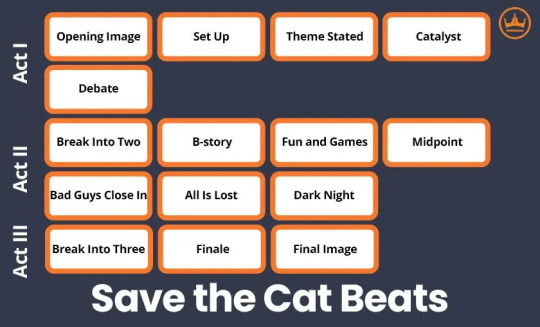
Above are the fifteen beats of Save the Cat and although KB on occasion doesn't hit all fifteen exactly as specified, especially final image as it's continuing, the song and dance is quite similar. Here are examples of The Dark Knight (2008) and Inglourious Basterds (2009), two movies that have inspired Hokazono's work.
Before Chihiro meets Char, we get his opening image of him and his dad forging which is works well as the entire story revolves on the consequences of them creating weapons. We get the set up to his world where he lives with his dad who made famous katanas that wield the power to end a war. The theme is stated, and it's not kept a secret: The katanas they make are weapons made to kill people. Are they willing to carry the burden? In another variation of this question, is Chihiro willing to carry the burdens unintentionally passed down by his father?
The catalyst is his father's murder that catapults him into seeking revenge and recover the katanas.
Now, for the rest of the story, this structure can be applied to the first 18 chapters or even 1-3 chapters at a time which in my opinion, is kind of insane. There's story telling inside the story telling, and these moments are both subtle and grand, signs of a strong and captivating writer. Hollywood would kill for a script like this these days. In order to get you to believe me how prominent these beats are, I'm going to do arc one and Daruma's story. The main story line should be around act one and two right now as of chapter 20, if we want to get down into it, but if anything, this feels like it's moving like a second "movie."
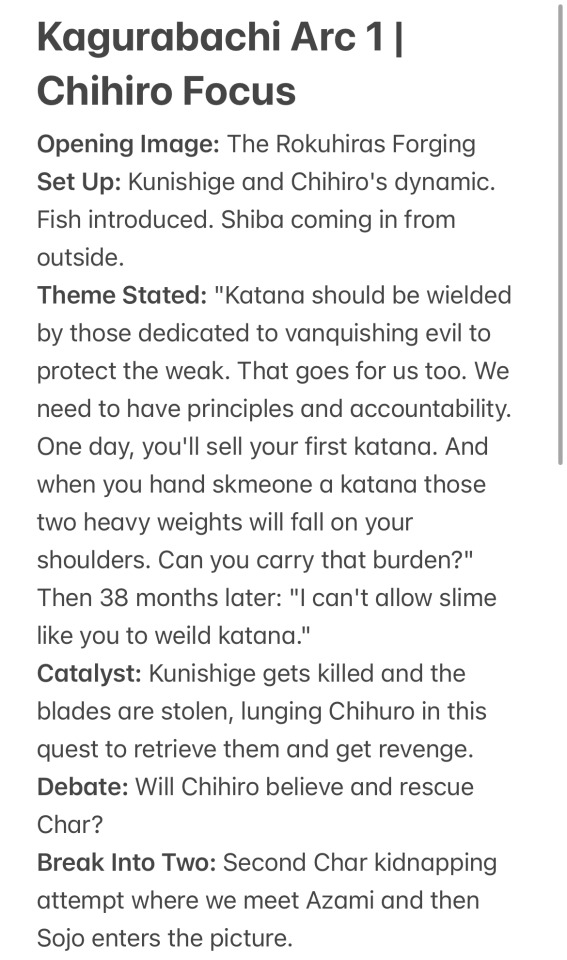
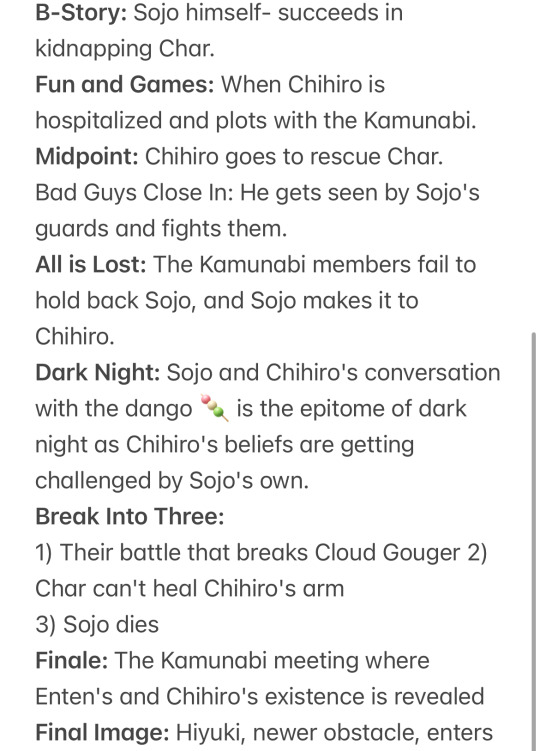
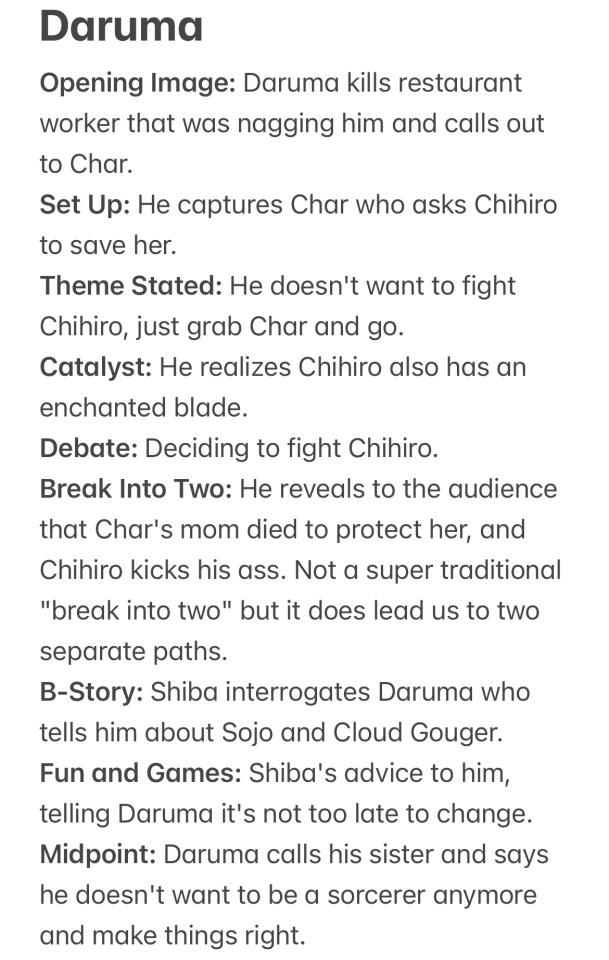

Overall, this structure that comes from Hollywood movies can be identified in multiples parts of Kagurbachi's storytelling. I was going to do beat sheet's for Char and Sojo's stories as well, but I think this is enough of an example of a bigger picture versus smaller. Although other mangas also fall into three act structures, as most story telling does, KB masterfully uses the 15 beats to its advantage. I believe the familiarity of this pace is what hooked oversea audiences, and aside from that, the characters that quickly capture us.
Very quickly, because I don't want to make this about characterization, Chihiro is well written through his past, who he chooses to kill and save, his dialogue that can be surprisingly vulnerable at times, and his cool façade that melts because of how hot he truly runs. He is also straight up a badass. We get handed Char's background in an "all is lost" segment as well as some lore that can present her as a resource for the main cast. We see Azami's phone background photo that's minimum 3+ years old- a government employee with a soft spot for his friends, one who he is still clearly grieving. We get one tiny yet so fucked up bit of Sojo when we see him get a flashback where he's a child and his single dialogue of "I truly love Kunishige Rokuhira," that launched his type of villainy in the maniacal fanboy category. Who does it like that? Nobody but Takeru Hokazono.
Thank you for reading this essay! I do have two other essays drafted, one on Sojo's possible return (I'm a delusional Sojo fan) and just his overall significance and impact as the first villain even if he doesn't return, and on Hiyuki plus servant leadership versus self service.
24 notes
·
View notes
Text
"In high school, I’d see a movie at the local arthouse — like Living In Oblivion or Smoke — and want to dress like Harvey Keitel or Steve Buscemi. When I was in college, at Carnegie Mellon University in Pittsburgh, and then starting out as an actor in New York, I’d go to a lot of thrift shops. I was dead broke, but from older movies, I had some loose appreciation of great style — Cary Grant, Paul Newman…that Ivy League look from the 50s and 60s."
Despite these steamy on-screen moments, off-screen, he’s a low-key family man; he’s been married to power publicist Simon Halls since 2011, and they’re raising three boys in Los Angeles. While the SAG/AFTRA strike prevented him from kissing and telling about his scenes with Messrs. Bailey and Cooper, it seemed a good time to check in with an old friend of the brand.
“Being a parent [of three boys] has taught me patience…they’re different people, so you want to give them the structure they need to survive and thrive, but also not dampen the spirit they come into the world with.”
"At a certain point you have to be true to yourself, and let the chips fall where they may. And by being true to myself, I ultimately ended up working with all the people I wanted to work with in the first place. It’s a very personal decision, and there shouldn’t be this one-size-fits-all dictum about coming out." Interview by Matt Bomer for Todd Snyder winter 2023


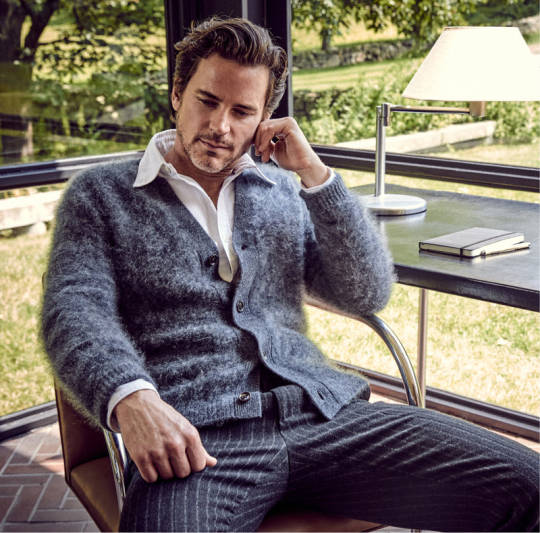



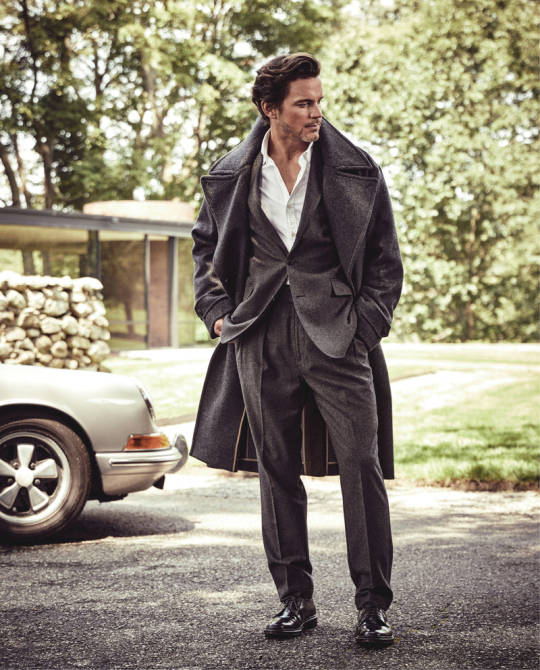
30 notes
·
View notes
Note
Wow😳…… your admission to similar gripes as I have actually does wonders to alleviate my apprehension. Not that I didn’t trust you to be careful with it before but this is certainly reassuring lol
I haven’t thought about the exploratory/conciliatory mode of fic writing in explicitly those terms but it can certainly be an engaging exercise. Now that I think of it my post s5 chloe wip kind of falls in that realm🤔 and true, the goals of fanfic writing vs original fiction writing can be similar or entirely different.
Might it be unwise to start reading tonight? Maybe I’ll have chapter 1 with breakfast. Cheers🎸
lol it's funny you say that! odnlb was practice for writing an original fiction story. (in a way, all my fanfics have been.) i had the idea for the main characters' emotional need, their Truth and Lie, and how they could change from beginning to end. it was that that made the fic pop wholly-formed into my head, i think. and at that point i just couldn't resist not writing it. but tbh, it's been such a fun ride to get into the rhythm of using save the cat structure. the fact that i wrote it around senti-adrien just kinda helped increase the stakes.
cheers to you too dude 🎸 happy reading if you decide to go for it!
12 notes
·
View notes
Text
S3 Won't Be Like S2, and That's Not a Bad Thing
So after the absolute cheese and crackers of this second season (plus that whollup of angst at the end) many Good Omens fans will be waiting for that next level of fluff and angst come S3. Don’t blame you at all.
However.
I think, should we be fortunate and get a new season at all, we must all be prepared for the reality that S3 is not going to be like S2, and remember too that this is not a bad thing.
Middle seasons/movies/books are notoriously tough to get right. Though they function as their own story, they’re also the middle part of an overarching plot. They are, in the plotting world (if you use Blake Snyder’s Save the Cat plotting structure terminology) the “fun and games” part of the plot. You get neither the interesting introduction of all character/plot/main conflicts, nor the highest stakes/climax/resolution of the end. So it’s really hard to keep that level of interest in a season that has no solid beginning or solid end of the main plot.
However, in this particular instance, Neil Gaiman and Co. have the absolutely wonderful benefit of having two main characters that most fans are content to watch paint dry with. The characters and their dynamics are the jewels of this story. So, this second season had another function. It was a “treat” season, in a way, because it slowed everything down and really let us indulge in the little, joyful things – aka, the developing relationship of Crowley and Aziraphale. Season One gave us a lot of that, too – but a great deal of that development was added for the show. With just the book as reference, it was a very plottish story. That’s why it required a season to pull off and not just a movie. On the other hand, if you took the events of S2 and converted it to a book of the same style (aka, focused mostly on the plot and the overall cast of characters, not as much on the main two) it would be significantly shorter.
Now, back to the subject of S3. This future season will be going back to the roots of Good Omens, because a big chunk of that plotting was done back when the original book was created. The major beats have been in place since 1990. So, it would probably be a fair bet to say that there will be a lot more plot-heavy beats, with less laser-focus on the relationship. Where S1 had several plots with one major one involving Adam as the antichrist, S2 was literally a romance story with a mystery element. S3, on the other hand, will likely be a return to form, and this isn’t a bad thing whatsoever. Many will be happy about this, because while it would be lovely to have an infinite amount of time just seeing the domestic side of an angel/demon relationship, we absolutely need some gritty, high-stakes plot points to round off this massively ambitious story.
It doesn’t mean we won’t get a lot of relationship things. We need it too, considering the build up we got S2. It is the heart of the whole story. I just think that S3 will be a perfect balance of what we liked of both S1 and S2. Where some would find S2 a little lacking in speed and stakes, S3 will be faster paced with bigger conflict. Where some find S1 to spend too much time away from the main relationship, S3 will absolutely focus on this as one of the two major plots of the story (S1/the book, on the other hand, had at least 4 plotlines that we switched between somewhat equally.)
So, when we think of S3 and theorize on its plot, we must think of it more in the context of S1/book rather than S2. We have to imagine that the major beats were figured out in the 90s, and focus on those unresolved setups we got in S2. So, we have the Book of Life, the Memory Wiping, and the Second Coming. I may also suggest the 25 Lazareth Miracle Concept, though I’d probably guess that it’s a modern Gaiman addition/enhancement with its focus on Crowley and Aziraphale’s “stronger together” theme (this theme enhancement was mostly a Gaiman addition in S1, remember, with the Ep 3 cold open and The Switch at the end). I’m still not positive whether this is going to end up being that an angel and demon working together makes the most powerful miracle (which would probably be more in-line with the original 90s plot) or if it’s specifically Crowley and Aziraphale; there would be very different plot possibilities with either. With the first, we could potentially have a return of Beelzebub and Gabrial as an Act 3 saving grace, and with the second they could literally have a “true loves kiss that saves the world” kind of thing, which I don’t think will happen (but Lord, can you imagine?)
All I know is that when a large chunk of S3’s original plot was conceived, the authors had no idea just how popular the angel and demon duo would be. It was written without that influence in mind. And I think this is a Good Thing. Because as much as we all want infinite content of Crowley and Aziraphale, there is always that danger of “too much of a good thing.” In getting only what we want, we would lose all those other parts that makes this story beloved.
Neil Gaiman said it himself, so many times. S2 is the “gentle and romantic” season. It is, in other words, the one that focussed on Crowley and Aziraphale’s relationship. He said also that he can’t guarantee the fans will even like season 3, and I don’t think that is because he’s going to do anything awful to our beloved characters. I think he’s simply being wary of fans who might take for granted that S3 will have that same level of fluff (affectionate) as S2, and this just won’t be the case. And I very much guarantee that even if we have a perfect level of relationship focus in S3, the sheer glut of it in S2 will create some disappointment and bitterness indeed.
In short: we are absolutely, without a doubt, NOT going to get that same level of sweet, domestic relationship stuff in Season 3 as we did in S2, and we all should try to avoid throwing undue expectation (and potential bitterness) at Neil Gaiman if there’s that distinct change of pace/tone. Because it doesn’t mean we won’t get a huge amount of relationship stuff in general (we could even get more); it just means it won’t be the sole focus, and it won’t be “gentle and romantic.” There won’t be plots about trying to put on a Jane Austin ball, or trying to play matchmaker for a local couple. There are going to be much higher stakes, with a lot more stuff happening. And this isn’t a bad thing. It’s what’s needed to make a well-rounded trifecta of seasons. So be prepared, set expectations, gird your loins, have a ton of fun in the meantime, and—most importantly—pray that S3 will be renewed at all.
#a lot of words to say please be nice to future Neil Gaiman#I do go on don't I#good omens#good omens 2 spoilers#good omens 2#go2 spoilers#gos2 spoilers#good omens s2 spoilers#good omens meta#good omens 2 meta#good omens 3#neil gaiman
37 notes
·
View notes
Text
[“Though no American would deny that tanks work in the desert, some Americans do deny that deserts are growing larger. Though no American would deny ballistics, some Americans do deny climate science. Hitler denied that science could solve the basic problem of nutrition, but assumed that technology could win territory. It seemed to follow that waiting for research was pointless and that immediate military action was necessary. In the case of climate change, the denial of science likewise legitimates military action rather than investment in technology.
If people do not take responsibility for the climate themselves, they will shift responsibility for the associated calamities to other people. Insofar as climate denial hinders technical progress, it might hasten real disasters, which in their turn can make catastrophic thinking still more credible. A vicious circle can begin in which politics collapses into ecological panic. The direct consequences of climate change will reach America long after Africa, the Near East, and China have been transformed. By then, it will be too late to act.
The popular notion that free markets are natural is also a merger of science and politics. The market is not nature; it depends upon nature. The climate is not a commodity that can be traded but rather a precondition to economic activity as such.
The claim of a “right” to destroy the world in the name of profits for a few people reveals an important conceptual problem. Rights mean restraint. Each person is an end in himself or herself; the significance of a person is not exhausted by what someone else wants from him or her. Individuals have the right not to be defined as parts of a planetary conspiracy or a doomed race. They have the right not to have their homelands defined as habitat. They have the right not to have their polities destroyed. When states are absent, rights—by any definition—are impossible to sustain. States are not structures to be taken for granted, exploited, or discarded, but are fruits of long and quiet effort.
It is tempting but dangerous to gleefully fragment the state from the Right or knowingly gaze at the shards from the Left. Political thought is neither destruction nor critique, but rather the historically informed imagination of plural structures—a labor of the present that can preserve life and decency in the future. One plurality is between politics and science. A recognition of their distinct purposes makes possible thinking about rights and states; their conflation is a step toward a total ideology such as National Socialism. Another plurality is between order and freedom: each depends upon the other, although each is different from the other.
The claim that order is freedom or that freedom is order ends in tyranny. The claim that freedom is the lack of order must end in anarchy—which is nothing more than tyranny of a special kind. The point of politics is to keep multiple and irreducible goods in play, rather than yielding to some dream, Nazi or otherwise, of totality.”]
timothy snyder, from black earth: the holocaust as history and warning, 2015
35 notes
·
View notes
Text
Unrelated to the main purpose of my blog, but if you’ll permit an excursion on this mini-crusade for a brief moment….can I just say that I really, REALLY don’t understand the fiery animosity that Rebel Moon is stoking across the internet?

I mean, yeah…heartbreakingly, Rebel Moon is not great. To say that I was not disappointed would be a lie. At the same time, it’s certainly nothing terrible. It never bored me, and it doesn’t commit any new sins…all of the story and structural problems in Rebel Moon are also present in Dune Part 1 and MI: Dead Reckoning Part 1 (especially Dune). But those apparently get a free pass. It’s no more generic & ripped off than any of Disney’s 2023 slate, or Percy Jackson and the JK Rowling Lawsuit, or any of the endless Oscar-bait biopics that get cranked off the printing press every December. The action was fun and the subtle backstory breadcrumbs the characters left behind were at least interesting enough to make me give Part 2 a chance, which is more than can be said for any recent Star Wars project. It’s all perfectly “fine.” So why is everyone on YouTube and Reddit and Letterboxd acting like the sci-fi genre just experienced the Second Coming of L. Ron Hubbard? What’s so offensive here?
Ever since the Snyder Cut came out, it really seems like there’s been a concentrated online push to delegitimize Zack Snyder as a filmmaker and paint his fans as psychopathic idiots, and it all feels so needlessly aggressive. I can’t help but think that the bile toward Rebel Moon has festered at least partly from factors outside the movie itself.
Overall, it’s a decent enough table-setting episode, and if the meal to come with Part 2 in April is worth it, then that’s fine with me. This is only half the story; treat it as such.
It’s like…sheesh, calm down, people. You have Wishes and Aquaman 2s that you could be crucifying.
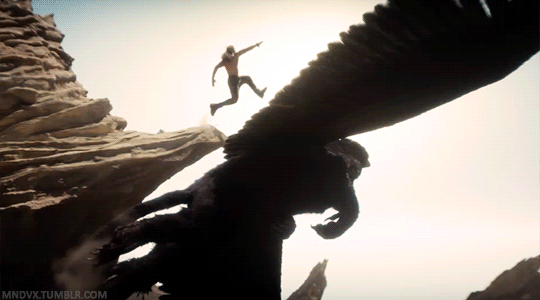
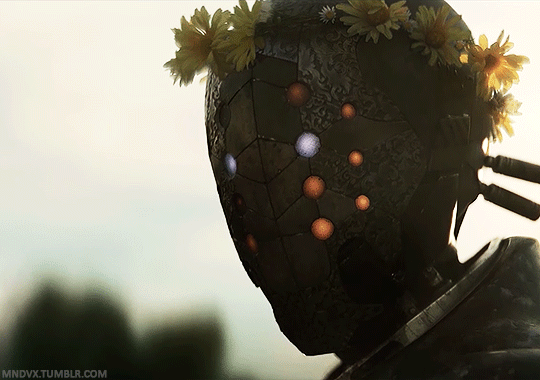
Also apparently in the extended director’s cut, Jimmy the Hopkins bot goes on a spiritual journey and starts living out in the woods like a feral homeless guy killing animals and shit, and FUCK YES I want to see that story.
#non tk#rebel moon#zack snyder#Snyder cut#a child of fire#rebel moon part one a child of fire#rebel moon part 1#kora rebel moon#netflix#mini rant#non tickling
12 notes
·
View notes
Note
hii! i'm a big fan of your fanfics, and as an aspiring writer myself, sometimes I feel sad 'cause I know and feel like I won't ever be as good as you are ☹️ I know I shouldn't compare myself, and I'm trying to get better at it, so I would genuinely like to ask, are there any tips you'd give to authors out there trying to improve? either their writing skills, plot ideas, planning and stuff. thank you, either way, love you! can't wait for your next work ❣️
So, the first thing I want to say is that I have been writing for a long time. I published my first fanfic when I was 12 years old and I’m 31 now, so I’ve been actively writing for the past 19 years (!!!) with almost no break. The way someone explained it to me once was to look at your years writing like levels in a video game. I’m currently at level 19. If you’ve been writing for ten years, you’re at level 10 and it’s certainly not fair to compare yourself to me because the only thing that’s truly going to make you a better writer is to write.
I’m assuming since you called yourself an “aspiring writer” that your eventual goal is publication, so I’ll gear my recommendations towards that. Fanfiction is a completely different animal, but a lot of these tips are applicable to both. The biggest difference is that there’s a lot more freedom in fanfiction. You can write what you want without worrying about three-act structures and you don’t have to invest any work in making people care about the characters because they already do. It is worth noting, however, that if you write, you’re already a writer.
First, I highly recommend that you read “Save the Cat” by Blake Snyder. It changed my life and I’m not even kidding. It’s an absolutely fantastic book on writing and although it’s geared towards screenwriting instead of novels, everything is still applicable. (There’s actually a newer version called Save the Cat Writes a Novel, but I’ve never actually read that one so I don’t know if it’s as good.) He goes over how to plot a story and also how to write likable characters, which is surprisingly one of the hardest parts of writing original fiction.
The second biggest tip I can give you is to let yourself write badly. Editing is easier than writing. The most important thing is to get words down on the page. You would not believe how bad my first drafts are—and that’s not just me being coy. Honestly, the next time I sit down to write a fanfic, I might save my first draft for anyone who’s interested to read because my first drafts are always bad. Like legitimately. There’s a lot of freedom in letting yourself fail and your writing will turn out better for it.
I would also recommend getting a professional critique if you are able to because you’re never truly going to know what it is you need to improve upon unless someone tells you. Signing up for a writing retreat is a great way to do this or you can look for online critiquing services. I’ve gotten several chapter critiques from Scribbler in the past and I found them very helpful.
But truly, the most important thing is to just have fun. I heard Lin-Manuel Miranda talking about writing Hamilton once and he said that what he constantly kept asking himself was, “If no one else ever sees this, will writing it still have been worth it?” And for him, it was. That’s the kind of energy I try to write with. I write what I want when I want and if I find myself struggling to write a scene because it’s boring, I do something to make it not boring instead. Change things up! Have fun! Because otherwise, what’s the point?
About six years ago, a friend of mine said virtually the same thing you did in this ask: “I’ll never be as good as you.” She had been writing for less than a year at the time. We lost touch when I left fandom to pursue original fiction, but when I came back last year, I looked her up again. She has a Tumblr ficlet pinned at the top of her page with 10K+ notes. I could never.
So don’t count yourself out yet. Just keep writing.
8 notes
·
View notes
Text
youtube
Timothy Snyder - this time talking about Russian (Muscovy) imperialism and colonisation of the entire span of Asia, and big chunks of Europe. How it came to be, how it was done, what is "All Russia" (Wszechruś) and why it's a fuzzy kind of entity, and how the way the country was managed at the time MAY give us the hints into why Russia is now socially structured in such a weird way from our point of view.
(and I mean our, as not "Western world" only, also our as next door neighbours of Russia - we KNOW the structure is f*ed up and why, but it's still weird, and also, it's nice to hear Professor Snyder explain it in brutally plain words)
Again, to my Central/Eastern Europe friends - share and reblog and show others. Snyder is the person to explain our local weird shit to Westerners in the way they will be able to understand. The guy knows us, but also knows how to speak about it to not-us....
121 notes
·
View notes